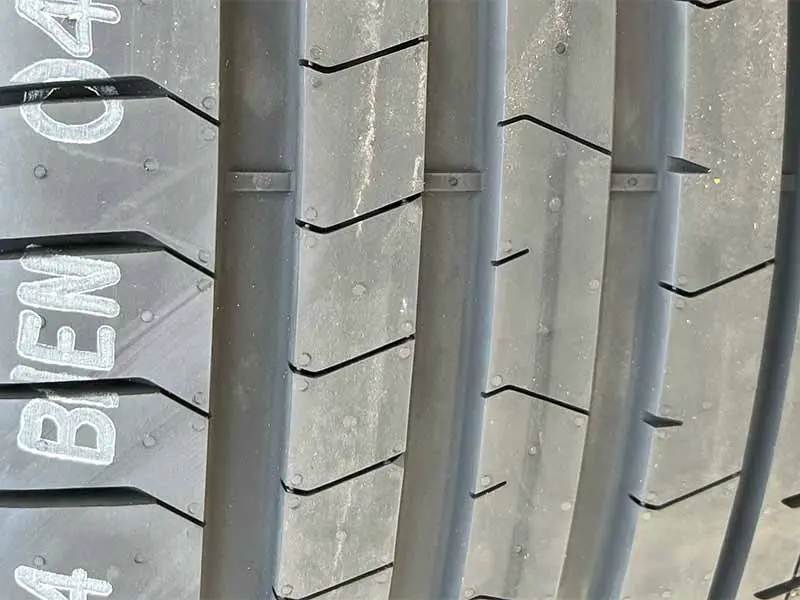Imagine cruising down the highway, the radio playing your favorite song, when suddenly you feel a loss of control, all because of a worn-out tire. Knowing how to read tread wear indicators isn’t just a nifty skill—it’s an essential tool in your driving arsenal that could save the day (or even a life)!
Tread Wear Indicator
Tread wear indicators, often found as raised sections interspersed in the grooves of your tire, signal when a tire’s tread has worn down to 2/32 of an inch or 1.6 millimeters, indicating a need for replacement.
In this article, we’ll dive deep into the world of tire treads, understanding wear bars, the importance of regular tire checks, the numerical science behind tread depth, and practical tips to ensure you’re always rolling safely on the road.
Let’s take a closer look.
The Basics of Tire Tread Depth
Tread patterns aren’t just for show; they have an essential job. They’re all about the tire tread depth, and here’s the scoop on why it’s super-duper important.
Why Should I Care?
- Wet Weather Champ: Deep treads help push water out from under the tire. This means less chance of your car doing the unwanted slidey-slide (also known as hydroplaning) on wet roads.
- Stopping Power: When you hit the brakes, the depth of your tire tread can make a big difference. Better tread depth usually means shorter stopping distances.
- Avoiding Flats: Nobody wants a flat tire, right? Keeping an eye on your tread depth can help avoid those pesky punctures.
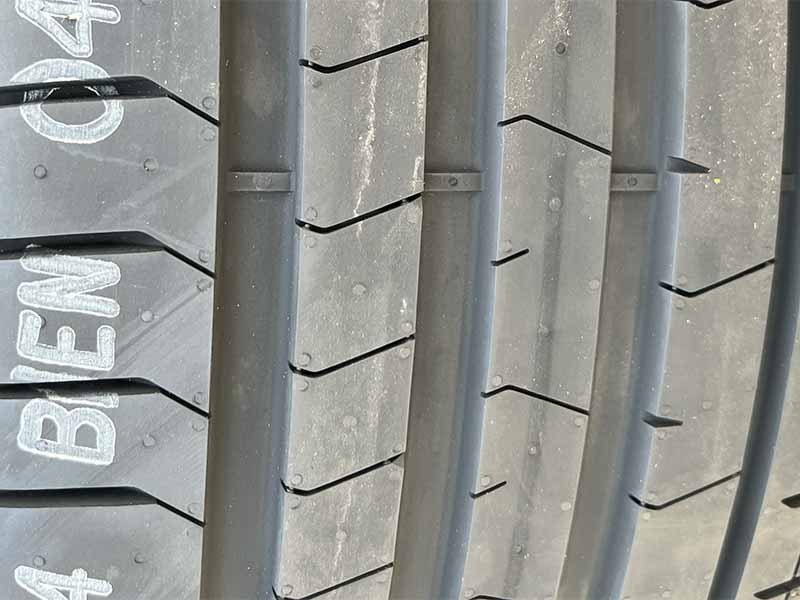
A Little Bit of Math (Don’t Worry, It’s Simple!)
Tire tread depth is usually measured in 32nds of an inch. Yep, that’s right—tiny fractions. Most tires start with a tread depth of about 10/32” or 11/32”. When it gets down to about 2/32”, it’s time to think about getting new tires. Remember:
- New Tires: Usually around 10/32” or 11/32” deep.
- Time for New Tires: When they hit 2/32” or thereabouts.
Other Methods For Measuring Tire Tread Wear
Want to know how deep (or shallow) your tire treads are? Well, there are a couple of cool tricks and tools for that, which we’ll dive into deeper in the next sections. But to tease a bit:
- The Penny Test: A simple trick using good ol’ Abraham Lincoln.
- Tread Depth Gauge: A nifty tool you can pick up at auto stores.
Tread Wear Indicators Explained
Let’s cover the specifics of tire wear indicators, also known as tire wear bars
What Are Tread Wear Indicators?
Tread Wear Indicators (let’s call them TWIs for short) are like little road-trip buddies built into your tires. They’re there to give you a heads up when your tire treads are getting too thin.
Wear bars are pretty much the same thing as TWIs. They’re just another name for them. Kinda like how some folks say “soda” and others say “pop.”
- Spotting Them: TWIs look like small raised sections that run between the treads of your tire. They’re like the lines between lanes on a road.
- Their Role: When the main part of your tire’s tread wears down to the level of these TWIs, it’s a big ol’ sign that says, “Time for new tires!”
Why Wear Bars Matter
So, you might be wondering, “Why all this fuss over little lines on tires?” Here’s the scoop:
- Safety First: TWIs and wear bars are your tire’s own built-in safety alert system. They let you know when your tires are no longer in their prime for gripping the road.
- Budget Friendly: By keeping an eye on these indicators, you can plan ahead for new tires rather than getting caught off guard.
- Peace of Mind: Knowing that you’re driving on tires with good tread depth can make your rides smoother, safer, and stress-free.
Measuring Tire Tread Depth
Okay, folks, let’s get a bit hands-on. Knowing about wear bars and tread depth is all well and good, but how do we put this knowledge into action? Let’s break down the ways you can become a tread-measuring pro.
Using a Tread Depth Gauge
Alright, if you’re serious about your tire game, this nifty little tool is your best friend.
- What it is: A tread depth gauge is a small tool, usually pocket-sized, that gives you a precise measurement of how deep those treads really are.
- How to use it:
- Find a spot between the treads (avoiding those wear bars).
- Insert the pin end of the gauge until it touches the base of the tread.
- Read the measurement. Most gauges will show you the depth in 32nds of an inch.
- Why it’s awesome: It’s super precise and gives you a clear idea of how much life your tire has left.

Tread Depth Gauge Example
The Penny Test
For those who love a good DIY trick, this one’s a classic.
- What you need: Just a penny. Yup, that’s it.
- How to do it:
- Take Mr. Abraham Lincoln on your penny and insert him head first into one of the tread grooves.
- If part of Abe’s head is always covered by the tread, you’re good to go. If you can see all of his head, those tires are probably too worn.
- Why it’s handy: It’s quick, easy, and doesn’t require any special tools. Plus, it’s a cool party trick (well, maybe at a car enthusiasts’ party).
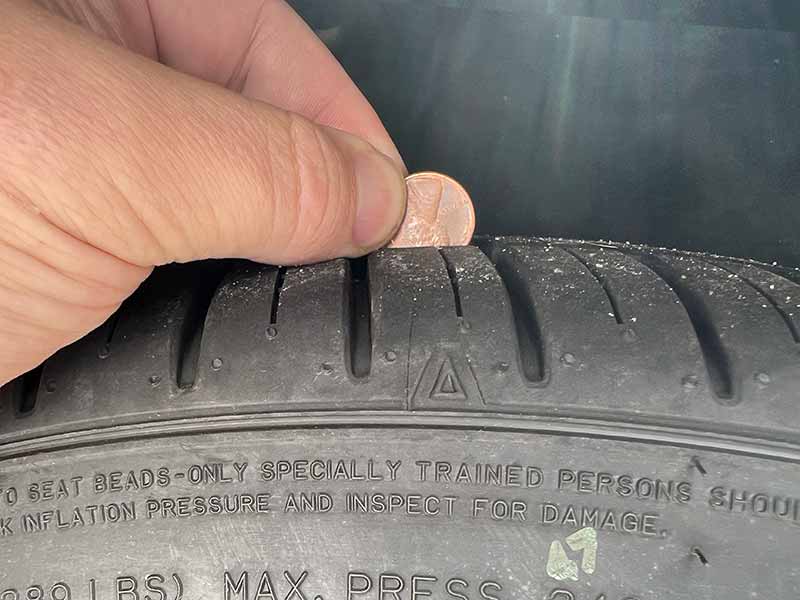
Checking Wear Indicator Bars
Now, this is where those wear bars come back into play.
- How to spot them: Look between the treads for the horizontal bars. If they’re flush with the tire tread, it’s time to consider new tires.
- Why they matter: It’s a built-in alert system. If you can easily spot and feel these bars, your tire is shouting, “Time for an upgrade!”
The Numbers Behind Tread Depth
Alright, fellow drivers, let’s take a moment to geek out on some numbers. If you’ve ever wondered what the digits and charts related to tire treads really mean, you’re in for a treat. Buckle up, and let’s get numerical!
Introduction to Tire Wear Indicator Chart
- What’s This Chart?: A tire wear indicator chart is basically a visual representation that lets you know how worn out your tire is, based on its tread depth. Think of it as the growth chart you might’ve had on your bedroom wall as a kid, but for your car’s tires.
- Why It’s Useful: It’s a quick reference. Instead of relying on guesses or gut feelings, this chart gives you concrete numbers about your tire’s condition.
What Depth Are Tread Wear Indicators
- The Magic Depth: Tread wear indicators (those little bars we’ve chatted about) usually show up when the tire tread depth gets down to about 2/32 of an inch or roughly 1.6 millimeters.
- What It Tells Us: When you can see these indicators level with the surface of the tread, it’s a clear sign that your tires are reaching their wear limit. In many places, it’s legally time for a change.
Safe Tire Tread Depth in Millimeters
- Beyond Inches: While many in the U.S. think of tread depth in inches, the rest of the world often uses millimeters. So, let’s talk mm.
- General Safety Marker: Ideally, you’d want to replace your tires before they hit the 2/32 inch (1.6mm) mark. For optimal safety, especially in wet conditions, having a tread depth of at least 4/32 inch (about 3.2mm) is recommended.
- Snowy Roads: If snow’s in the forecast, 5/32 inch (or about 4mm) is the golden number to keep in mind for maintaining good traction.
How the Tread Depth of a New Tire Typically Looks
- Fresh Out of the Box: Brand new passenger car tires typically have a tread depth of about 10/32 inch to 11/32 inch, which translates to roughly 7.9mm to 8.7mm.
- Why So Deep?: This depth provides optimal performance, longevity, and a buffer for wear over time. So when you get new tires, they’re not only looking fresh but they’re packed with depth for many safe miles ahead.
- Evolution Over Time: Remember, as you clock in more miles, the depth will decrease. It’s the natural life cycle of a tire.
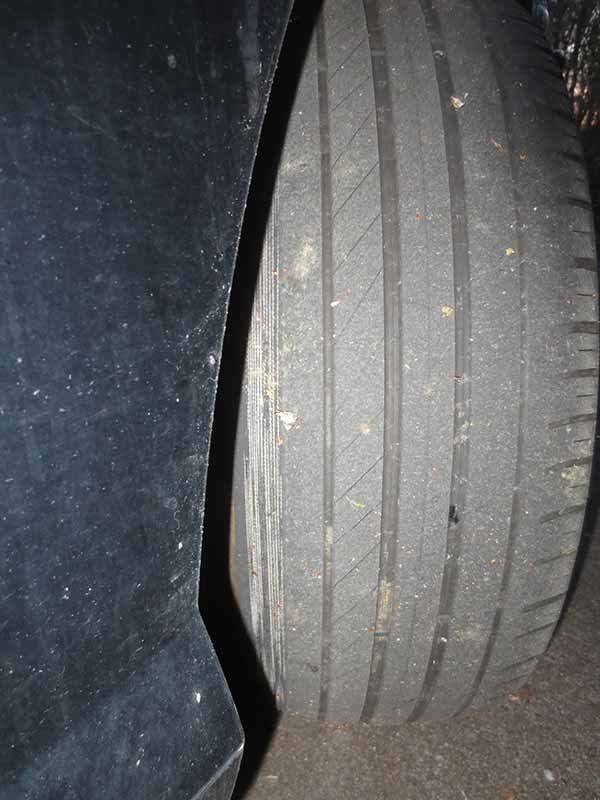
Safe Tire Tread Depth
Safety first, am I right? Tire tread depth isn’t just about making sure your ride looks snazzy—it’s critical for keeping you safe on the road. So, let’s break down what is considered a safe tire tread depth and why it matters big time.
The Magic Number: 2/32 Inch
Alright, let’s cut straight to the chase. The general rule of thumb (or tire) is:
- Legal Minimum: Most places, especially in the U.S., set the minimum safe tread depth at 2/32 of an inch.
- Why 2/32”?: At this point, your tire’s built-in wear bars (remember those?) become flush with the surface. It’s like the tire’s natural alarm system telling you it’s time for a change.
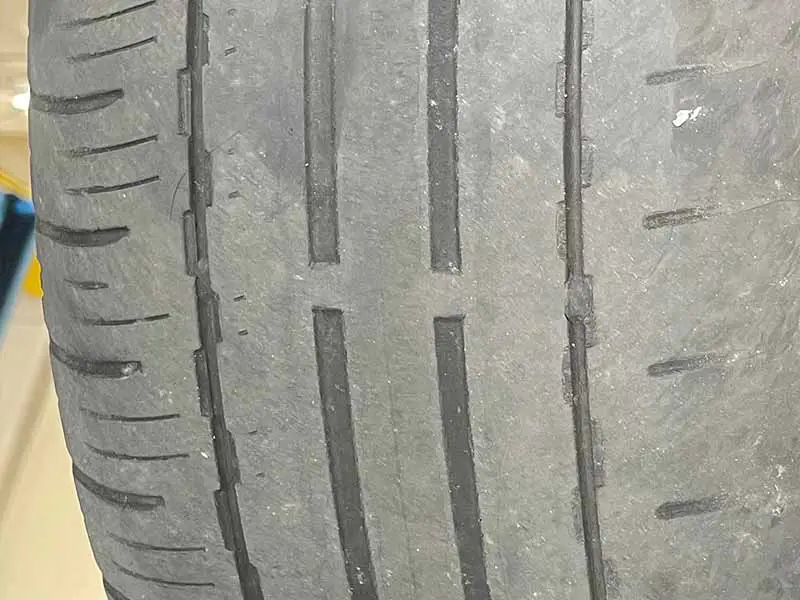
Beyond the Minimum: Optimal vs. Legal
While 2/32” is the legal minimum, it doesn’t mean it’s the optimal depth for all conditions. Consider this:
- Wet and Slippery Roads: For rainy conditions, you’d want more tread. A depth of around 4/32” is where you start losing significant wet traction.
- Snowy Terrain: If snow is a regular guest in your area, aiming for at least 5/32” is a wise choice to maintain good snow traction.
The Risks of Low Tread Depth
Running on low tread isn’t just a minor inconvenience. It comes with real-world consequences:
- Hydroplaning: Worn treads can’t channel water effectively, increasing the risk of hydroplaning (where your tires literally float on water).
- Longer Stopping Distances: Thin tread depth can increase your braking distance, especially on wet roads.
- Blowouts: Worn tires are more vulnerable to punctures and blowouts. Trust me, a sudden flat tire at highway speeds is no fun.
Checking Depth Regularly: A Habit Worth Forming
- Monthly Checks: It’s a good idea to check your tire tread depth once a month. It only takes a few minutes with a tread depth gauge or the penny test.
- Seasonal Changes: Before winter or the rainy season, do a thorough check to ensure you’re prepared for slippery roads.
Resources
Below are some links you may find helpful when learning about tires
Final Thoughts
Tread wear indicators are like a built-in alarm system for your tires, signaling when it’s time for a replacement. By understanding wear bars, regularly checking tire treads, and keeping in mind the critical numbers behind tread depth, you’re taking a proactive approach to your safety and those around you on the road.
So, before your next drive, give those tires a quick glance—ensuring they’re in top shape might just be the simplest way to guarantee smoother and safer journeys ahead.
Good luck and happy motoring.
